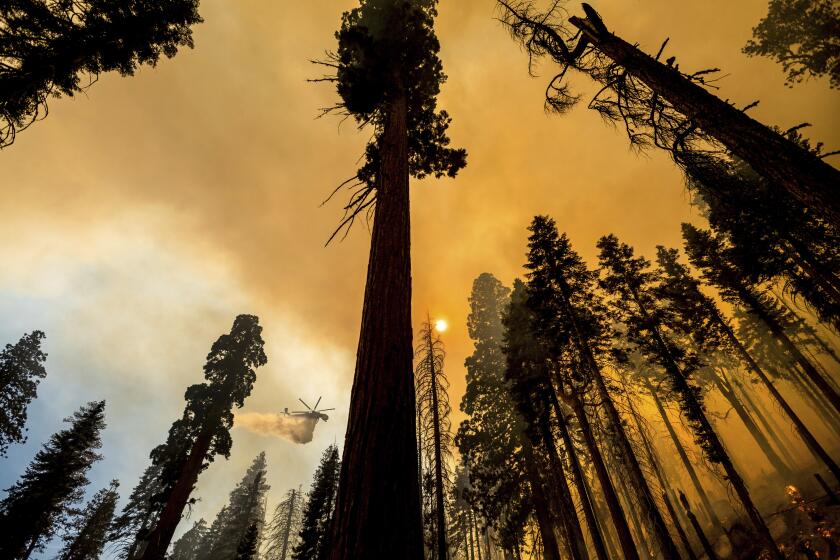Opinion: Here’s how the Save Our Sequoias Act will hurt California’s beloved trees

Act would create a hole in National Environmental Policy Act regulations big enough for a logging truck to drive through.
Ross is a writer and Sierra Club San Diego Chapter chair. She lives in Del Mar Mesa.
“Beware of false prophets, which come to you in sheep’s clothing.” — Matthew 7:15
Who could argue against protecting California’s’ majestic millennia-old sequoia trees, the oldest and biggest on Earth, from destructive fires and infestations exacerbated by drought conditions? Dozens of environmental groups — when legislation claiming to do so is not only redundant but at the service of weakening environmental protections on behalf of a panoply of special interests hoping to bring more commercial development into our national forests.
Opponents of the Save Our Sequoias Act claim that adapting the environmental review to save sequoias is a ‘slippery slope’ that will lead to industrial-scale logging and weakening of federal laws. That’s false.
Shepherded by House Minority Leader Kevin McCarthy, R-Bakersfield, not known for possessing even a green baby finger, and strangely co-authored by Rep. Scott Peters, D-San Diego, the proposed precedent-setting legislation euphemistically called the Save Our Sequoias Act (H.R. 8168) would create a hole in National Environmental Policy Act regulations big enough for a logging truck to drive through.
The widespread opposition to the bill among environmental groups, with 80 signatories to an opposition letter sent to Congress, is evidence that Sierra Club forestry experts were not consulted in crafting the bill.
In fact, the legislation caught all of us at the Sierra Club San Diego Chapter by surprise last month when it surfaced in the news media.
This is not the stuff of effective, informed, collaborative lawmaking, and it should be summarily rejected.
The herd of so-called Save Our Sequoias Act supporters count among their numbers logging and paper industries hostile to environmental regulatory processes that they deem cumbersome impediments to commercial aims in all of America’s federally protected forests.
The act masks an attempt to shear off regulatory tools established in the 1970s under the Nixon administration’s National Environmental Policy Act that requires federal agencies to assess the environmental effects of their proposed actions prior to making decisions. Back then, conservation was a conservative idea.
The legislation would charge a group of appointees, called the “Giant Sequoia Lands Coalition,” with management decision-making powers for this fragile ecosystem in lieu of the regular public and scientific environmental review process.
The National Environmental Policy Act was established to ensure transparency and public participation and importantly, that scientific evidence is the primary consideration for project approvals, including for fire mitigation activities. This is especially important for the health of our most fragile forest ecosystems like those within Sequoia National Park.
Further, the National Environmental Policy Act already pragmatically excludes from intensive environmental analysis projects that do not significantly impact the environment like authorized trail repair or minor fixes to existing structures. These “categorical exclusions” were not meant to circumvent public scrutiny of fire prevention measures.
The Save Our Sequoias Act sets a precedent for easing approvals for other potentially harmful projects for commercial purposes in the nation’s endangered forests suffering from the effects of climate change, undoing over 30 years of regulation.
The unique groves of sequoia trees, while covering a relatively small, 15-mile-wide, 250-mile-long area along the western Sierra Nevada Mountains, encompass a stunningly diverse ecosystem of wildlife and waterways, some rare and endangered. This complexity requires science-based interventions to avoid inadvertently destroying entire communities.
While we have inherited problems with wildfire and infestations from years of fire exclusion policies in our forests, climate change is increasingly taking its toll, a fact that, not surprisingly given Rep. McCarthy’s lack of real leadership on climate change issues, the Save Our Sequoias Act legislation fails to address.
As for the protective warm fuzzy messaging of caring for the sequoia trees that’s wrapped around the core of this deceptive legislation, measures to manage the forest by strictly adhering to standard practices under the National Environmental Policy Act are already underway.
Last month, the U.S. Department of Agriculture’s Forest Service announced that emergency actions using existing authorities under the National Environmental Policy Act have been initiated and will start as soon as this summer and fall with funding from the Biden infrastructure bill.
And a package of 48 bills called the Wildfire Response and Drought Resiliency Act (H.R. 5118) is winding its way through the House of Representatives. In its current form, this package would address the most critical problems facing the Forest Service by providing funding for hazardous fuel reduction projects and filling gaps in Forest Service personnel tasked with managing forest drought conditions.
The Sierra Club supports the Biden administration’s efforts to preserve our forests. But the Save Our Sequoias Act does nothing to protect healthy forest ecosystems and everything to erode established means of supporting them.
Borrowing from medieval storytelling, pulling the wool over our eyes “to pick pockets” is no way to conduct environmental policy.
Get Weekend Opinion on Sundays and Reader Opinion on Mondays
Editorials, commentary and more delivered Sunday morning, and Reader Reaction on Mondays.
You may occasionally receive promotional content from the San Diego Union-Tribune.






